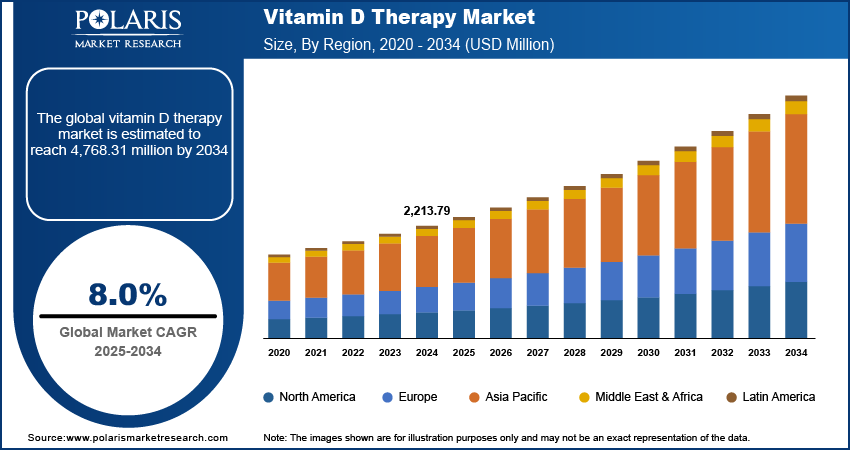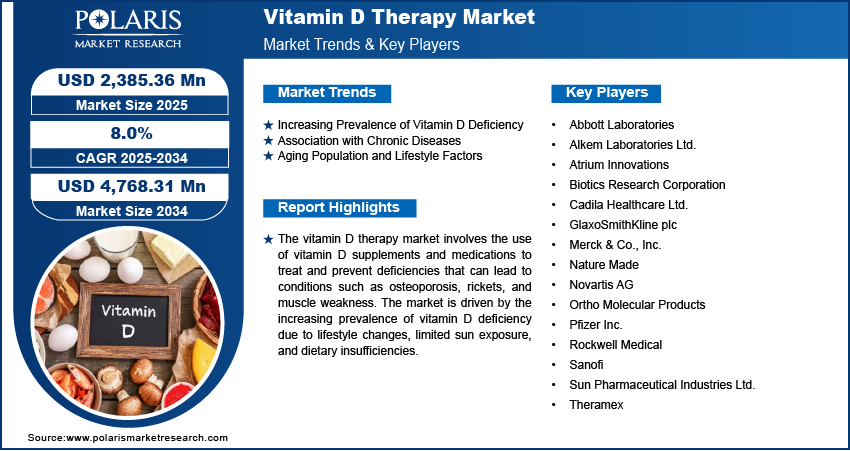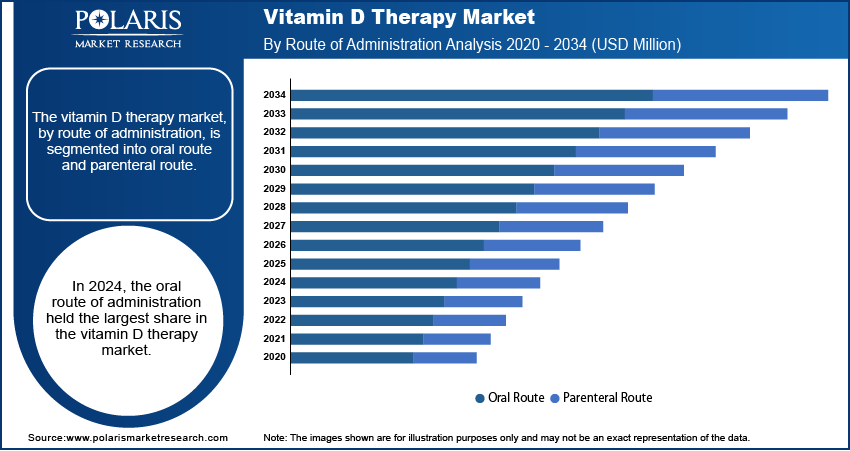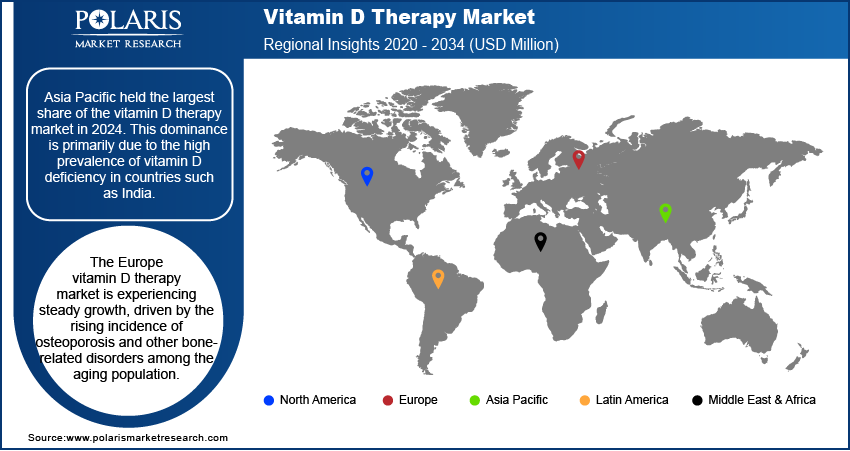
Vitamin D Therapy Market Size, Share, Trends, Industry Analysis Report: By Route of Administration (Oral Route and Parenteral Route), Age Group, Purchase Pattern, Application, and Region (North America, Europe, Asia Pacific, Latin America, and Middle East & Africa) – Market Forecast, 2025–2034
- Published Date:Apr-2025
- Pages: 119
- Format: PDF
- Report ID: PM3350
- Base Year: 2024
- Historical Data: 2020-2023
Vitamin D Therapy Market Overview
The vitamin D therapy market size was valued at USD 2,213.79 million in 2024. The market is projected to grow from USD 2,385.36 million in 2025 to USD 4,768.31 million by 2034, exhibiting a CAGR of 8.0% during 2025–2034.
The vitamin D therapy market focuses on the treatment and prevention of vitamin D deficiency and related disorders, including osteoporosis, rickets, and autoimmune diseases.
The market is driven by the increasing prevalence of vitamin D deficiency due to lifestyle changes, limited sun exposure, and dietary insufficiencies. Additionally, the rising geriatric population, growing awareness of the health benefits of vitamin D, and the increasing incidence of chronic diseases contribute to market growth. The demand for vitamin D supplements, fortified foods, and pharmaceutical formulations continues to rise, supported by government initiatives and clinical research highlighting the role of vitamin D in bone health, immunity, and overall well-being.

To Understand More About this Research: Request a Free Sample Report
Vitamin D Therapy Market Dynamics
Increasing Prevalence of Vitamin D Deficiency
The rising incidence of vitamin D deficiency is a significant driver of the vitamin D therapy market expansion. Globally, approximately 1 billion individuals are affected by vitamin D deficiency, with about 50% of the population experiencing vitamin D insufficiency. In the US, data from the National Health and Nutrition Examination Survey (NHANES) 2024 indicate that 5% of the population aged 1 year and older have serum 25-hydroxyvitamin D levels below 12 ng/mL, and 18% have levels between 12 and 19 ng/mL. This widespread deficiency has heightened awareness and demand for vitamin D supplementation and therapy.
Association with Chronic Diseases
Vitamin D deficiency has been linked to various chronic health conditions, including osteoporosis, cardiovascular diseases, diabetes, and certain cancers. For instance, vitamin D plays a crucial role in bone health by facilitating calcium absorption; inadequate levels can lead to osteoporosis and an increased risk of fractures. Additionally, research suggests that low vitamin D levels may be associated with a higher risk of cardiovascular diseases and autoimmune disorders. These associations have prompted healthcare providers to recommend vitamin D therapy as a preventive and therapeutic measure, thereby driving vitamin D therapy market growth.
Aging Population and Lifestyle Factors
The aging global population contributes to the increased demand for vitamin D therapy. Older adults are at a higher risk for vitamin D deficiency due to factors such as reduced skin synthesis capacity and limited sun exposure. As per Medscape 2024 report, approximately 61% of the elderly population is vitamin D deficient in the US. Modern lifestyle factors, including increased indoor activities and the use of sunscreen, further reduce natural vitamin D synthesis. These trends necessitate the use of vitamin D supplements and fortified foods, thereby propelling the vitamin D therapy market.

Vitamin D Therapy Market Segment Insights
Vitamin D Therapy Market Assessment – Route of Administration-Based Insights
The vitamin D therapy market, by route of administration, is segmented into oral route and parenteral route. The oral route segment held the largest market share in 2024. This dominance is attributed to its ease of use, cost-effectiveness, and high patient compliance. Oral supplements, available in various forms such as tablets, capsules, and liquids, offer flexibility and convenience, allowing individuals to manage their vitamin D intake without medical supervision. This method is particularly advantageous for large-scale public health initiatives aimed at addressing widespread vitamin D deficiencies, as it facilitates mass distribution and self-administration. The non-invasive nature of oral administration further enhances its acceptance among diverse populations, including children and older adults.
The parenteral route segment, involving injections, is primarily utilized in clinical settings for patients with specific medical conditions that impair oral absorption or require rapid correction of severe deficiencies. While effective, this method is less favored due to the need for healthcare professional involvement, potential discomfort, and higher costs associated with injectable forms. Consequently, the parenteral route occupies a smaller market share compared to oral administration.
Vitamin D Therapy Market Evaluation – Age Group-Based Insights
The vitamin D therapy market, by age group, is segmented into children, adults, and senior adults. The senior adult segment held the largest market share in 2024. This is primarily due to the increased prevalence of osteoporosis and other bone-related disorders among older adults, necessitating vitamin D supplementation to maintain bone density and reduce fracture risks. As individuals age, their skin's ability to synthesize vitamin D diminishes, and they often experience reduced sun exposure, leading to higher deficiency rates. Consequently, healthcare providers frequently recommend vitamin D therapy for this demographic to support musculoskeletal health and overall well-being.
The adult segment is experiencing significant growth within the vitamin D therapy market. Factors contributing to this trend include rising awareness of vitamin D's role in immune function and chronic disease prevention, as well as lifestyle factors such as indoor occupations and increased use of sunblock, which limit natural vitamin D synthesis. Additionally, dietary habits may not provide sufficient vitamin D, prompting adults to seek supplementation. Public health campaigns and emerging research continue to highlight the importance of maintaining adequate vitamin D levels, further driving the adoption of vitamin D therapy among adults.
Vitamin D Therapy Market Outlook – Purchase Pattern-Based Insights
The vitamin D therapy market, by purchase pattern, is segmented into OTC drugs and prescription drugs. The OTC drugs segment held the largest share of the market in 2024. This prominence is attributed to the accessibility and convenience of OTC vitamin D products, which can be purchased without a prescription from pharmacies and online retailers. This ease of access enables consumers to proactively manage their vitamin D levels, contributing to the widespread adoption of OTC supplements. The growing awareness of vitamin D's health benefits has further propelled the demand for these readily available products.
The prescription drugs segment is experiencing significant growth within the vitamin D therapy market. This growth is driven by the increasing diagnosis of vitamin D deficiencies and related disorders, prompting healthcare providers to prescribe specific dosages tailored to individual patient needs. Prescription formulations often address more severe deficiencies or medical conditions requiring monitored therapy. The involvement of medical professionals ensures appropriate treatment plans, fostering patient trust and adherence to prescribed vitamin D regimens.
Vitamin D Therapy Market Assessment – Application-Based Insights
The vitamin D therapy market, by application, is segmented into osteoporosis, rickets, skin diseases, muscle weakness, and autoimmune disorders. The osteoporosis segment accounted for the largest market share in 2024. This is primarily due to the high prevalence of osteoporosis, a condition characterized by weakened bones and an increased risk of fractures, particularly among the elderly population. Vitamin D plays a crucial role in calcium absorption and bone metabolism, making its supplementation essential in the prevention and management of osteoporosis. Healthcare providers frequently recommend vitamin D therapy to enhance bone density and reduce fracture risks in individuals diagnosed with or at risk for osteoporosis. The widespread occurrence of this condition underscores the significant demand for vitamin D-based therapeutic interventions.
The autoimmune disorders segment is experiencing notable growth within the vitamin D therapy market. Emerging research suggests that vitamin D possesses immunomodulatory properties, potentially influencing the immune system's response and reducing the incidence or severity of autoimmune diseases such as multiple sclerosis, rheumatoid arthritis, and type 1 diabetes. This has led to an increased interest in vitamin D supplementation as a complementary approach to managing these conditions. Patients and healthcare practitioners are increasingly considering vitamin D therapy to potentially modulate immune function and improve clinical outcomes in autoimmune disorders. This growing recognition of vitamin D's role in immune health is driving the expansion of its therapeutic applications beyond traditional bone-related ailments.

Vitamin D Therapy Market Regional Analysis
By region, the study provides the vitamin D Therapy market insights into North America, Europe, Asia Pacific, Latin America, and the Middle East & Africa. Asia Pacific held the largest share of the vitamin D therapy market in 2024. This dominance is primarily due to the high prevalence of vitamin D deficiency in countries like India. Factors contributing to this deficiency include limited dietary intake of vitamin D, low exposure to sunlight, and a predominantly vegetarian diet, which may lack sufficient vitamin D sources. These challenges have led to an increased demand for vitamin D therapy in the region. Additionally, government initiatives and public health campaigns aimed at addressing malnutrition and promoting vitamin D supplementation further bolster the market's growth in the region.
The Europe vitamin D therapy market is experiencing steady growth, driven by the rising incidence of osteoporosis and other bone-related disorders among the aging population. Countries such as Germany and the UK have implemented government recommendations for vitamin D intake, especially during months with limited sunlight exposure. The increasing demand for fortified food products and supplements, along with a well-established healthcare infrastructure, supports the market development in this region. Moreover, the presence of key market players and ongoing research into the health benefits of vitamin D further enhance the market's growth prospects in Europe.

Vitamin D Therapy Market – Key Players and Competitive Insights
The competitive landscape of the vitamin D therapy market features global and regional players competing through innovation and strategic alliances. Global players leverage R&D capabilities and technological advancements to deliver advanced solutions, meeting the demand for disruptive technologies. Market trends highlight rising technological adoption driven by economic growth and geopolitical shifts. Companies focus on strategic investments, mergers, and joint ventures to strengthen market positions. Regional players offer cost-effective solutions tailored to local needs. The market experiences ongoing technological transformation, with companies investing in supply chain management and sustainability strategies. Competitive intelligence and pricing insights are critical for identifying growth opportunities. The industry's growth is driven by technological innovation, market adaptability, and strategic regional investments, ensuring sustained competitiveness in a dynamic global market. The vitamin D therapy market features several key players actively contributing to its growth and development. Notable companies include Abbott Laboratories; Sanofi; GlaxoSmithKline plc; Pfizer Inc.; Merck & Co., Inc.; Ortho Molecular Products; Novartis AG; Alkem Laboratories Ltd.; Sun Pharmaceutical Industries Ltd.; Cadila Healthcare Ltd.; Biotics Research Corporation; Atrium Innovations; Theramex; Rockwell Medical; and Nature Made.
Abbott Laboratories specializes in the healthcare and diagnostics industry, actively contributing to Vitamin D therapy through innovative products and solutions. The company offers various Vitamin D therapies, such as Calcijex (calcitriol) and Zemplar (paricalcitol), which are widely used for managing secondary hyperparathyroidism (SHPT) in patients undergoing hemodialysis. These therapies help suppress parathyroid hormone levels, maintain mineral metabolism, and prevent bone diseases, fractures, and cardiovascular complications associated with end-stage renal disease. Additionally, Abbott Architect 25-OH Vitamin D assay, a fully automated test cleared by the FDA, enables rapid and precise measurement of vitamin D levels to address widespread deficiencies. This assay supports healthcare professionals in diagnosing conditions like rickets, osteoporosis, autoimmune disorders, and cardiovascular diseases linked to low vitamin D levels. Abbott’s efforts in re-standardizing its assays against NIST standards further enhance accuracy in detecting vitamin D insufficiency and monitoring supplementation effectiveness.
Biotics Research Corporation, founded in 1976 and headquartered in Rosenberg, Texas, is a leader in the development and manufacturing of nutritional supplements. The company is renowned for its commitment to innovation and quality, focusing on scientifically researched concepts and advanced manufacturing techniques to produce superior products. Biotics Research serves healthcare professionals exclusively, offering a broad range of supplements designed to address various health needs. Their approach integrates cutting-edge research, clinical studies, and strict quality control processes to ensure efficacy and safety. In the realm of Vitamin D therapy, Biotics Research plays a substantial role by providing high-quality vitamin D supplements tailored to support bone health, immune function, and overall wellness. Their products are developed using modern analytical methods and undergo rigorous testing to guarantee potency and purity. Vitamin D therapy is particularly crucial for addressing deficiencies linked to conditions such as osteoporosis, rickets, and autoimmune disorders. Biotics Research ensures that its vitamin D offerings meet the highest standards by leveraging innovative delivery systems and maintaining control over raw material selection and production processes.
List of Key Companies in Vitamin D Therapy Market
- Abbott Laboratories
- Alkem Laboratories Ltd.
- Atrium Innovations
- Biotics Research Corporation
- Cadila Healthcare Ltd.
- GlaxoSmithKline plc
- Merck & Co., Inc.
- Nature Made
- Novartis AG
- Pfizer Inc.
- Sanofi
- Sun Pharmaceutical Industries Ltd.
- Theramex
Vitamin D Therapy Industry Developments
- November 2024: TTGV initiated a print campaign to enhance awareness of vitamin D deficiency.
- February 2024: Cadila Pharma introduced the world’s first aqueous formulation of cholecalciferol for treating vitamin D deficiency. This advancement offers improved pharmacokinetics (PK) and pharmacodynamics (PD) compared to conventional oil-based cholecalciferol formulations available in the market.
Vitamin D Therapy Market Segmentation
By Route of Administration Outlook (Revenue – USD Million, 2020–2034)
- Oral Route
- Parenteral Route
By Age Group Outlook (Revenue – USD Million, 2020–2034)
- Children
- Adults
- Senior Adults
By Purchase Pattern Outlook (Revenue – USD Million, 2020–2034)
- OTC Drugs
- Prescription Drugs
By Application Outlook (Revenue – USD Million, 2020–2034)
- Osteoporosis
- Rickets
- Skin Diseases
- Muscle Weakness
- Autoimmune Disorders
By Regional Outlook (Revenue – USD Million, 2020–2034)
- North America
- US
- Canada
- Europe
- Germany
- France
- UK
- Italy
- Spain
- Netherlands
- Russia
- Rest of Europe
- Asia Pacific
- China
- Japan
- India
- Malaysia
- South Korea
- Indonesia
- Australia
- Vietnam
- Rest of Asia Pacific
- Middle East & Africa
- Saudi Arabia
- UAE
- Israel
- South Africa
- Rest of Middle East & Africa
- Latin America
- Mexico
- Brazil
- Argentina
- Rest of Latin America
Vitamin D Therapy Market Report Scope
|
Report Attributes |
Details |
|
Market Size Value in 2024 |
USD 2,213.79 million |
|
Market Size Value in 2025 |
USD 2,385.36 million |
|
Revenue Forecast by 2034 |
USD 4,768.31 million |
|
CAGR |
8.0% from 2025 to 2034 |
|
Base Year |
2024 |
|
Historical Data |
2020–2023 |
|
Forecast Period |
2025–2034 |
|
Quantitative Units |
Revenue in USD million and CAGR from 2025 to 2034 |
|
Report Coverage |
Revenue Forecast, Market Competitive Landscape, Growth Factors, and Trends |
|
Segments Covered |
|
|
Regional Scope |
|
|
Competitive Landscape |
|
|
Report Format |
|
|
Customization |
Report customization as per your requirements with respect to countries, regions, and segmentation. |
How is the report valuable for an organization?
Workflow/Innovation Strategy: The vitamin D therapy market has been segmented into detailed segments of route of administration, age group, purchase pattern, and application. Moreover, the study provides the reader with a detailed understanding of the different segments at both the global and regional levels.
Growth/Marketing Strategy: Companies in the vitamin D therapy market focus on product innovation, strategic partnerships, and geographic expansion to strengthen their market presence. Many pharmaceutical and nutraceutical firms invest in research and development to introduce new formulations, such as chewable tablets and fortified food products, to enhance consumer compliance. Marketing strategies include collaborations with healthcare professionals and awareness campaigns to highlight the importance of vitamin D supplementation. Digital marketing and e-commerce platforms play a crucial role in reaching a broader consumer base. Additionally, regulatory approvals and clinical trials are prioritized to ensure product safety and efficacy, contributing to market growth.
FAQ's
The vitamin D therapy market size was valued at USD 2,213.79 million in 2024 and is projected to grow to USD 4,768.31 million by 2034.
The market is projected to register a CAGR of 8.0% during the forecast period.
North America had the largest share of the market in 2024.
Notable companies in the market include Abbott Laboratories; Sanofi; GlaxoSmithKline plc; Pfizer Inc.; Merck & Co., Inc.; Ortho Molecular Products; Novartis AG; Alkem Laboratories Ltd.; Sun Pharmaceutical Industries Ltd.; Cadila Healthcare Ltd.; Biotics Research Corporation; Atrium Innovations; Theramex; Rockwell Medical; and Nature Made.
The oral route of administration segment accounted for the largest share of the market in 2024.
The senior adults segment accounted for the largest share of the market in 2024.
Vitamin D therapy refers to the use of vitamin D supplements or medications to prevent and treat vitamin D deficiency and related health conditions. It is commonly prescribed to individuals with insufficient vitamin D levels, which can lead to bone disorders such as osteoporosis and rickets, as well as muscle weakness and certain autoimmune diseases. The therapy can be administered through oral supplements, fortified foods, or parenteral (injectable) forms, depending on the severity of deficiency and patient requirements. Healthcare professionals recommend vitamin D therapy to improve calcium absorption, support bone health, and maintain overall physiological functions.
Companies offering Vitamin D therapies related services, and other consulting firms must buy the report.
